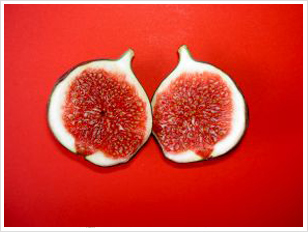The Common Fig tree is widely grown for its soft, sweet fruit. The fruit has many small seeds inside it, and its skin is very thin. Thousands of cultivars, most unnamed, have been developed or come into existence as human migration brought the fig to many places outside its natural range. It has been an important food crop for thousands of years, and is also thought to be highly beneficial in the diet.
The edible fig is one of the first plants cultivated by humans. Nine subfossil figs of a parthenocarpic type, dating back to about 9400–9200 BC, were found in the early Neolithic village Gilgal I – in the Jordan Valley, 13 km north of Jericho. This find predates the domestication of wheat, barley and legumes, and may thus be the first known instance of agriculture.
Figs were also a common food source for the Romans. The fruits were used, among other things, to fatten geese for the production of a precursor of foie gras.
Figs can be eaten fresh or dried, and used in jam-making. Most commercial production is in dried or otherwise processed forms, since the ripe fruit does not transport well, and once picked does not keep well.
Figs are one of the highest plant sources of calcium and fibre. Dried figs are richest in fibre, copper, manganese, magnesium, potassium, calcium and vitamin K. They have smaller amounts of many other nutrients, and also have a laxative effect and contain many antioxidants.
Reference: Wikipedia






I agree with you.I hope that helps.